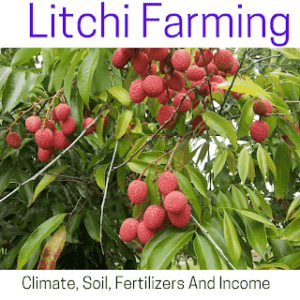Litchi is a small round fruit covered by thick red coloured bark. It has a white fleshy aril and a single seed. Its tree is of medium size. This fruit native to the provinces of Kwangtung and Fukien, Southern China. Despite being a delicious and much sought-after fruit, its expansion is slow due to its particular climate requirement.
China is the leading producer of Litchi followed by India, Thailand and Australia. Most places around the world prefer it as a table fruit, whereas China and Japan prefer it canned. Apart from its taste, it is also nutritionally rich. Some nutrients found in Litchi are:-
Litchi fruit belongs to the Litchi genus of Sapindaceae family.
Litchi Farming
Litchi farming is one of the lucrative businesses in horticulture. One established the trees will produce litchi for many years to come. They need little care and management as compared to other fruit trees. The market demand of this fruit is also increasing day by day which ultimately increases the earning and profit potential.

Climate
Litchi farming is best suited to Subtropical climate with a moist environment. It can be grown up to the altitude of 10000 masl where average annual precipitation is around (75-125) cm. Too high and low temperature limits the growth and yield. The optimum temperature for Litchi is (15-28) C. Places with temperatures above 40 C in summer and below 0 C in winter aren’t favourable for this tree. High temperatures cause fruit cracking while low temperatures cause chilling injury.
Variety Selection
Selection of good variety is a crucial step in litchi farming because it will determine our ultimate profit. We should select those varieties which are best suited for our climate and which give very good production. Some of the best varieties of Litchi fruit are listed below:-
•Calcuttia
•Dehradun
•Rose Scented
•Saharanpur
•Muzaffarpur
•Khatti
•Gulabi
Land Preparation And Soil
In litchi farming, soil testing is a very important and primary procedure. It helps us to know about nutrient availability in soil, pH, Soil texture and many more. After soil testing, the deficient things in soil should be added followed by tillage.
The selected land should be levelled, previous crop residues should be burnt or removed, Primary tillage should be done followed by harrowing. There should be a proper drainage facility to avoid the stagnation of water.
Litchi farming can be done in a variety of soil. Sandy loam soil with pH of (7-8.5) is ideal. Both acidic and alkaline soils restrict the growth of plants.
Planting And Propagation
Litchi can be easily propagated through seeds, cuttings and air layering (Best). Plants grown from seeds take much more time for fruiting than cuttings and air layering. Air layering in Litchi can be done at the beginning of Monsoon and can be detached from the mother plant after 60-70 days. The best planting time is Aug-Sept. Planting distance of 10m 10m should be maintained which leads to around 200 plants per ha. It is necessary to dig pits of 1m 1m 1m dimension a few weeks prior to planting of seedlings. After digging pits, they are left undisturbed for about 15-20 days. This will kill all the harmful organisms and fungi through soil solarisation. Each pit is filled after 20 days with top soil, 20-25 kg FYm, 2kg Bonemeal, 300g MOP. A small hole should be made at the centre of the pit for planting. Light irrigation should be done after planting. Square system of layout of orchards is good for litchi plantation.
Irrigation
Irrigation should be given immediately after planting. Irrigation at an interval of (2-3) days is beneficial during the initial growth phase of a plant. It is recommended to irrigate more frequently during early growth stages and in the summer than later growth stages and in the winter. To control fruit cracking, (3-4) irrigations during fruit growth is essential. Mulching with leaves is also effective to preserve the soil moisture.
Fertilisers
After flowering and before fruiting i.e when the litchi is of mustard size we should spray 3gm sulphur dissolved in 1 litre of water. It acts as insecticides and increases temperature and our fruiting increases. When the litchi are the size of peas we should apply boron to the soil. 3Gm borates mixed with 1 litre water should be applied. This will end the problem of fruit dropping and fruit cracking. The recommended doses of different fertilisers at different ages of Litchi plant is given below:-
Harvesting
Flowering of litchi starts in february after (5-6) years of plantation. The optimum production of litchi is obtained after 12 years and gives production up to 100 years. We should harvest litchi after they become a little red. We should harvest them along with stalks of length (20-25)cm. The yield is around (1.5-3) Quintals from a single tree. From an area of 1 acre, (150-300) Quintals of litchi can be harvested.
Storage
We should try to sell litchi in fresh condition. If we can’t sell, then we can store them.
We can store litchi at the temperature of (4.4-6.1)°c with 90% relative humidity.
Intercropping
Intercropping is the cultural operation of growing crops in between the main crop until the main crop starts to produce. As litchi takes (5-6) years to start fruiting, we can do intercropping for initial 4 years. Crops like Ginger, Turmeric, Cucumber, Bitter Gourd, Ridge Gourd and Cow Pea can be intercropped with litchi.
Common Problems
Pests
•Fruit borer
•Litchi Mite
•Leaf Miner
Diseases
•Downy Mildew
•Anthracnose
•Red Rust
•Root Rot
Conclusion
Finally, As litchi is one of the most loved fruit worldwide, Its farming will be very profitable for many years to come. As of now, Small number of entrepreneurs are involved in commercial farming.
